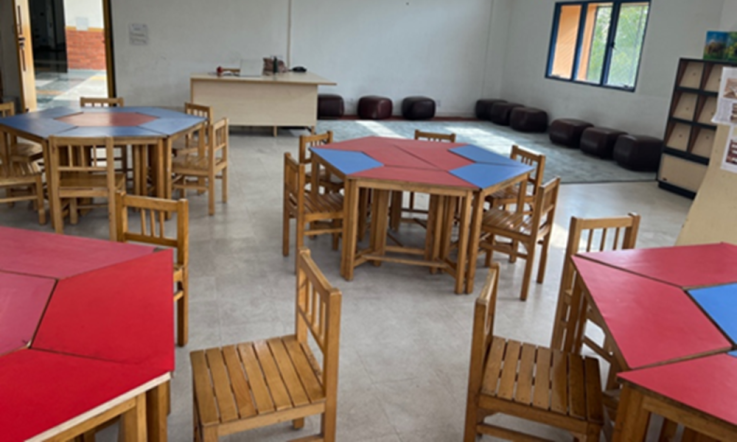‘The future of education lies in empowering every student's voice, ensuring that their perspectives shape a more inclusive and responsive educational system.’ In our latest reader submission, Divya Kapoor – Headmistress at ASPAM Scottish School, Noida – shares examples of student voice initiatives from her own school, and others around the world.
In the traditional landscape of education, students have often occupied a passive role, functioning as recipients of knowledge rather than active contributors to the learning process. However, a significant paradigm shift is underway, acknowledging the transformative potential inherent in amplifying and empowering the voices of students.
At the international level the United Nations Convention on the Rights of the Child (United Nations 1989) Article 12, gives children the right to express their views in matters that affect them. This transition marks a departure from the traditional hierarchical structure, recognising the wealth of insights, perspectives, and innovative ideas that students bring to the table.
By recognising and harnessing the unique perspectives of students, we embark on a journey towards educational practices that not only cater to the diverse needs of learners, but also instill a sense of ownership and empowerment in the very individuals the system is designed to serve.
Benefits of amplifying student voice
Improved student engagement and motivation
When students feel that their voices are heard and valued, they become more engaged in the learning process. Having a say in their education helps to make learning relevant and meaningful to them. Moreover, the opportunity to express opinions and ideas allows students to connect with the curriculum on a personal level, fostering a genuine interest in the subject matter.
Enhanced critical thinking and problem-solving skills
Actively participating in discussions and decision-making processes requires students to think critically about various issues. They learn to analyse information, consider different perspectives, and form well-reasoned arguments. It also helps students appreciate and respect differences. Furthermore, problem-solving skills are developed as students work collaboratively to address challenges or propose solutions.
Building communication and interpersonal skills
Expressing thoughts and ideas in a respectful and constructive manner is a crucial skill. Amplifying student voice provides opportunities for students to refine their communication skills both verbally and in writing. Collaborative projects promote the development of interpersonal skills, such as active listening, empathy, and the ability to work effectively in a team. It also helps boost their confidence and self-esteem.
Potential challenges for educators and administrators
Unequal participation
Challenge: Some students may be hesitant to voice their opinions, leading to unequal participation.
Strategy: Create a supportive environment where all voices are valued. Incorporate various communication channels, such as written submissions or online forums, to accommodate different comfort levels.
Limited resources
Challenge: Schools with limited resources may struggle to implement student voice initiatives effectively.
Strategy: Explore cost-effective solutions, such as online platforms or simple feedback mechanisms. Collaborate with community partners or leverage technology to maximize the impact of available resources.
Resistance from colleagues
Challenge: Colleagues who are unfamiliar with or resistant to the concept of student voice may hinder implementation efforts.
Strategy: Foster a culture of collaboration and open communication among staff. Share success stories and research findings to demonstrate the benefits of incorporating student perspectives.
Balancing student input with educational goals
Challenge: Striking a balance between incorporating student input and adhering to curriculum goals and standards.
Strategy: Align student voice initiatives with educational objectives. Engage students in topics related to the curriculum, ensuring that their input contributes to, rather than detracts from, the learning outcomes.
Examples of success in schools
Across the world, a growing number of schools are recognising the transformative power of student voices. From innovative pedagogies to community-focused initiatives, these institutions are providing platforms for students to actively contribute to decision-making processes. Here is more information about what we do at ASPAM Scottish School, and a few other examples I’d like to share from my own professional networking and reading.
ASPAM Scottish School, Noida, UP
Initiative: ASPAM Scottish School, Noida embraces an inquiry-based learning model, placing students at the forefront of their educational journeys. Here the focus is on pedagogical strategies which aim to privilege students’ own cultural histories and forms of knowing (Kincheloe & Steinberg, 1998) and to actively engage students as producers of knowledge via, for example, students-as-researchers projects (Fielding, 2001). The school actively promotes student-led projects, fostering creativity and critical thinking.
Impact: Through this approach, ASPAM Scottish School has instilled in its students a profound sense of curiosity and ownership over their learning experiences, winning awards and earning recognition for its commitment to innovative pedagogy.
Strategies implemented at ASPAM Scottish for amplifying student voice:
- At ASPAM we aim to cultivate a classroom and school culture that embraces diversity of thought, ensuring that all students feel comfortable expressing their opinions.
- We establish clear communication guidelines, set expectations for respectful communication and active listening during class discussions, creating a safe space where students feel valued without fear of judgment.
- We incorporate student input in decision-making. Students are actively involved in decisions related to classroom activities and projects to instill a sense of ownership and responsibility.
- We utilise technology for anonymous feedback. Online surveys allow students and parents to share their thoughts ensuring a comprehensive representation of perspectives.
- We establish and support student councils that play a key role in decision-making processes, providing a structured platform for student input.
- We encourage Student-Led Projects to align with their interests, fostering autonomy and responsibility.
- We implement Peer Mentoring Programs where older students mentor younger ones, creating a supportive environment for sharing experiences and concerns.
- We also celebrate student achievements which help reinforce the value of student contributions and encourage continued participation.
The Heritage School, Kolkata, West Bengal
Initiative: The Heritage School in Kolkata adopts a student-centered approach, facilitating collaborative learning and encouraging active student participation in decision-making through forums like the Student Council.
Impact: It has cultivated a positive and inclusive school culture where students feel empowered and valued. The engagement of students in shaping school activities has led to heightened enthusiasm and a strong sense of community.
Shikshantar, Udaipur, Rajasthan
Initiative: Shikshantar is an alternative education space that champions learner autonomy and community involvement. Students are encouraged to design their learning paths, with active involvement in decisions about the curriculum and community projects.
Impact: Shikshantar has emerged as a hub for innovative education practices in India, demonstrating the potential for student-led learning to nurture creativity and a lifelong passion for learning.
Student-led conferences at Ames High School, Iowa
Initiative: Ames High School has implemented student-led conferences where students actively participate in discussions about their academic progress, goals, and areas for improvement. Parents, teachers, and students engage in collaborative conversations during these conferences.
Impact: This initiative has led to improved communication between students, parents, and educators. Students take ownership of their learning by reflecting on their achievements and areas for growth, fostering a sense of responsibility and accountability.
High Tech High, San Diego, California
Initiative: High Tech High is renowned for its project-based learning approach, where students play a central role in shaping their educational experience. Students are involved in designing projects, setting learning goals, and even participating in the hiring process of teachers.
Impact: This student-driven model has resulted in increased engagement, higher academic achievement, and the development of critical thinking and collaboration skills. School leaders report that students often graduate with a strong sense of ownership over their learning, well-prepared for future academic and professional challenges.
The role of technology in enhancing student voice
Technology has become a powerful catalyst for amplifying student voices, providing innovative platforms that transcend traditional classroom boundaries. The integration of online platforms, social media, and digital tools has transformed the landscape of education, offering new avenues for collaborative decision-making and meaningful student engagement. Some examples of technology-enabled student engagement that we implement as ASPAM Scottish School are:
- Student blogs and podcasts: Students create blogs or podcasts to share reflections on class topics, showcase projects, and voice opinions on issues that matter to them. This personalised form of expression allows students to develop digital literacy skills while fostering a sense of ownership over their learning narratives.
- Virtual student council meetings: Student councils leverage video conferencing tools to conduct virtual meetings, enabling students to actively participate in decision-making processes. These ensure that all students, regardless of location, can contribute to important discussions and initiatives at any point of time.
- Online collaborative projects: Students use collaborative platforms like Padlet, Wakelet, and Coggle to work together on projects, exchanging ideas and co-creating content. This digital collaboration enhances teamwork skills and exposes students to diverse perspectives, preparing them for collaborative efforts in the professional world.
- Interactive online polls and quizzes: Educators use online polling tools to gather real-time responses from students on class topics, gauging understanding and preferences. Interactive polls provide immediate feedback, allowing educators to tailor lessons based on student comprehension levels and adapt to their interests.
Final thoughts
From enhanced engagement to the development of critical skills, student input is integral to a vibrant learning environment. Technology helps amplify this potential, providing platforms for expression and collaboration. The call to action is clear: educators, administrators, and policymakers must integrate student voices into decision-making.
This commitment isn't just a pedagogical strategy; it's a dedication to a student-centric education that prepares individuals for success in this dynamic world. The future of education lies in empowering every student's voice, ensuring that their perspectives shape a more inclusive and responsive educational system.
References
Fielding, M. (2001). Students as radical agents of change. Journal of Educational Change 2: 123–41.
Kincheloe, J., and S. Steinberg. (1998). Students as researchers: Critical visions, emancipatory insights. In Students as researchers: Creating classrooms that matter, ed. J. Kincheloe and S. Steinberg, 2–19. London: Falmer Press.
United Nations. (1989). United Nations convention on the rights of the child. UN General Assembly Resolution 44/25. Geneva, Switzerland: United Nations.
In this article, Divya Kapoor shares 8 strategies implemented at ASPAM Scottish School for amplifying student voice. On your own or with colleagues, take a look at the list and think about your own school context. Which strategies do you already employ? Which one could you introduce this term? What staff support and resources will you need to make it happen? How will you monitor its impact?



